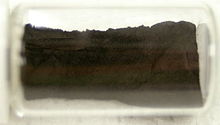
Back ثنائي بوريد المغنيسيوم Arabic منیزیوم دیبورید AZB Magnesiumdiborid German Boruro de magnesio Spanish منیزیم دیبورید Persian Magnesiumdiboridi Finnish Diborure de magnésium French Diboruro di magnesio Italian 二ホウ化マグネシウム Japanese 이붕화 마그네슘 Korean

| |

| |
| Identifiers | |
|---|---|
3D model (JSmol)
|
|
| ChemSpider | |
| ECHA InfoCard | 100.031.352 |
| EC Number |
|
PubChem CID
|
|
CompTox Dashboard (EPA)
|
|
| |
| |
| Properties | |
| MgB2 | |
| Molar mass | 45.93 g/mol |
| Density | 2.57 g/cm3 |
| Melting point | 830 °C (1,530 °F; 1,100 K) (decomposes) |
| Structure | |
| Hexagonal, hP3 | |
| P6/mmm, No. 191 | |
Except where otherwise noted, data are given for materials in their standard state (at 25 °C [77 °F], 100 kPa).
| |
Magnesium diboride is the inorganic compound with the formula MgB2. It is a dark gray, water-insoluble solid. The compound has attracted attention because it becomes superconducting at 39 K (−234 °C). In terms of its composition, MgB2 differs strikingly from most low-temperature superconductors, which feature mainly transition metals. Its superconducting mechanism is primarily described by BCS theory.